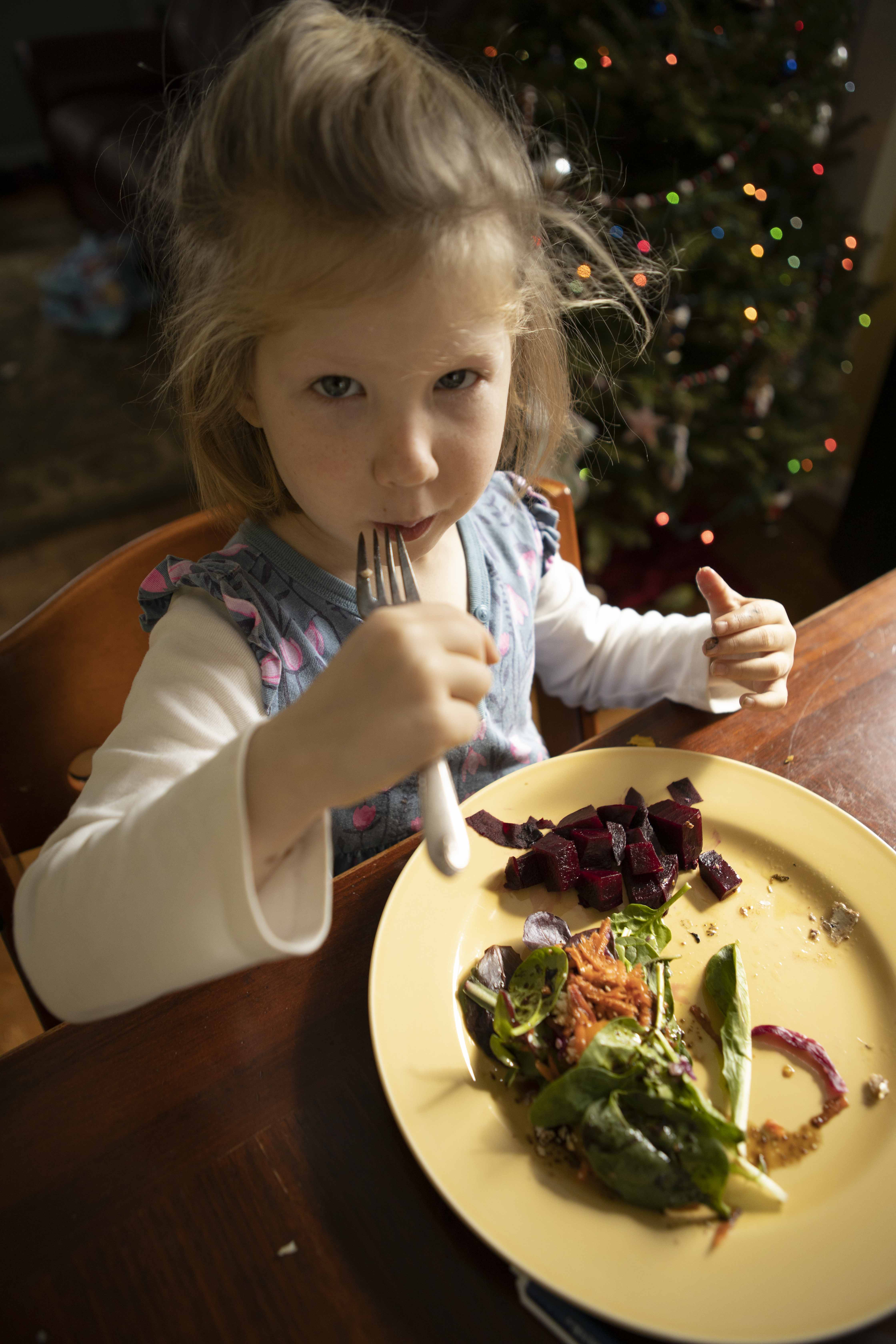
Disclaimer: The following recommendations are not meant to be treated as medical advice. Contact your CF team’s dietician and work closely with medical professionals to implement a specific feeding intervention strategy for your family.
Parenting is full of contradictions, confusion, and what often feels like too many details to keep up with. One of such topics that I’ve found to be especially challenging is how to deal with picky eating and nurturing a healthy relationship with food in children. I’m a health coach and had worked with kids and college students in nutrition, gardening, and environmental education for about five years when I became a mother.
My first-born has severe food allergies – some resulted in inadequate weight gain as a baby while others result in anaphylaxis. Figuring out what to feed to an allergic child was complicated, and I found that I relied upon a fairly limited diet in fear of accidentally introducing an offensive food. When he was around 20 months of age, our pediatrician mentioned that I’d be feeding him his “special” foods for a lifetime if I never offered something different. She recommended that I start offering him the foods that my husband and I were enjoying, and nothing else.
“Brilliant!” I thought. “Yes, let’s get this kid on the adventurous eating train!” As it turned out, I was wildly naïve to the process that ensued and the following two or three weeks were miserable.

When my daughter with CF came along three years later I had the experience and confidence to know that I didn’t have to offer “kid-friendly” foods; she’d eat whatever I gave her as long as I set consistent expectations that the offered food would be the only choice. Given her risk of malnourishment, I wouldn’t have approached a change in diet the same as I did with my son. I instead focused on preventing the issue altogether. Kids only know what they’re exposed to; I only exposed her to the foods I wanted her to eat.
I don’t claim to have all the answers when it comes to teaching your child to enjoy healthy foods. Each family unit is unique, my family continues to have struggles, and different approaches work under different circumstances. There are numerous factors, especially when dealing with a child with malnourishment, that must be considered in the development of an appropriate intervention plan. In depth strategies for those who are in crisis are not discussed. I’ll instead share what I feel has been most helpful in my own family in the development of healthy eating patterns.
The absolute most important part of getting kids to eat healthfully is for parents to make necessary changes first. Kids, especially younger children, model their parent’s behavior. If a parent models unhealthy or picky eating, a child will learn to do the same. So even if your child won’t enjoy the same healthy foods that you eat, they’re at least being repeatedly exposed to those foods and internalizing the message that “this is how we eat”. The same is true for exercise. It’s simply unrealistic to hold our children to a standard that we can’t meet. If we want our children to lead healthy lives, we’ve got to be the example that we want our children to follow.
My husband and I set the example regarding the foods that will be eaten, and these are the foods that are served to our kids with very few exceptions. Parents have been deceived by marketers in that we’ve been led to believe that our kids will only eat “kid-friendly” foods – these are easy and convenient calories with easy tastes and textures. Teaching a child to learn to enjoy raw vegetables like carrots and red peppers is a more difficult feeding skill than teaching them to enjoy donuts or chicken nuggets.

For those of you with children who repeatedly refuse foods, you may find comfort in knowing that a child will often refuse a new food 8 – 13 times before trying it, but parents most often stop offering new foods after they’ve been refused just 3 or 4 times. I’ve even heard that kids will refuse a food for up to a year before finally trying it. Just keep offering, no matter how long it takes. Serving an unfamiliar food along with something that you know your child will enjoy is the most beneficial and successful way to encourage a positive exposure. Sometimes an exposure to a food is as simple as the child touching, smelling, or playing with something new (playing with food is okay!), but not actually tasting it. Serving a food that your child enjoys at every meal will be especially important for the individuals who struggle with weight gain. You always want to guarantee adequate intake at every meal.
One of the CF moms that I spoke with about eating behaviors said that despite her dedication to diet, her son still went through a picky eating phase. He’d throw tantrums over food and she simply ignored the negative behavior. She didn’t try to persuade him otherwise or feed into the tantrums; she simply avoided eye contact and pretended as if nothing was happening. As frustrating as this was, her lack of response taught him that inappropriate behavior would not result in an altered outcome or attention. I think this is a great example of how we have to separate our emotions from our child’s eating choice. Try to remember that your job is to offer healthy foods (alongside foods that they’re known to enjoy as to ensure adequate intake) and then it’s their choice whether they’re going to eat it. Forcing them to try foods, especially in instances where the child may have sensory issues, will only create negative pressure around foods. Rather than encouraging your child to eat, you can instead try saying things like, “do you think the carrot with be crunchy? What happens when you break it in half?” And then move on to more important questions like “are you still learning about dinosaurs in school?” Remain warm and calm, don’t put too much attention on the food, and don’t make meal times uncomfortable by only focusing on what has or hasn’t been eaten.

My final advice is to be open and receptive to whatever tools and tricks might work for your own situation. Childhood feeding in complicated, especially when dealing with a disease like CF that can impact a child’s appetite, energy levels, physical comfort, and other factors influencing hunger. Unfortunately, there is no one-size-fits-all approach, but I’m confident that by implementing the gently persuasive strategies listed above and working with your CF team, you can make healthy eating a part of your family’s life.
____________________

Leah lives in the mountains of North Carolina with her husband, T. C., and her two children, Owen and June. Owen has a life-threatening anaphylactic allergy to wheat, and June has cystic fibrosis. Leah’s commitment to a nutrient-dense diet has played an important role in her children’s integrative care. Her book, The Grain-Free, Sugar-Free, Dairy-Free Family Cookbook is a complete guide for families interested in learning how to efficiently cook more made-from-scratch meals. Leah obtained her health coach certification from the Institute for Integrative Nutrition after earning a Bachelor of Science degree in Environmental Biology and a Master of Public Health degree in Environmental Health Sciences. She has worked in nutrition and gardening education since 2009 with a focus on engaging children in healthy eating habits through experiential learning and discovery. Leah started and runs the Deep Rooted Wellness blog, on which she posts stories and tips regarding nutrition, gardening, and healthy families.
***Views expressed in the CFLF Blog are those of the bloggers themselves and not necessarily of the Cystic Fibrosis Lifestyle Foundation***
***Please speak with your physician before making any changes to your CF management***
Add new comment